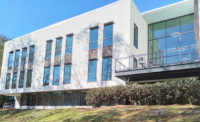Buildings
Unfinished Chicago Condo Redeveloped as Apartments
Capitalizing on new demand for apartment dwellings, Related Midwest, a unit of New York City-based Related Cos., plans to convert an unfinished Chicago condominium into a 65-story, 500-unit luxury apartment building. The Chicago-based developer Teng & Associates originally planned to construct a 90-story condominium-hotel on the site, but the company only completed a 27-story concrete shell before running out of money in 2008. Property records indicate Related Cos. paid $26 million in late July for the structure, which is located on Wacker Drive. Other area developers, including Michael Reschke and Mark Goodman, previously considered converting the structure to hotel and office space. Related Cos. also plans to build a 500-unit apartment building at Chicago's 500 N. Lake Shore Drive.
Alternative Energy
Stimulus Funded Project Rescued by Pipeline Developer
Calgary, Alberta-based oil and gas pipeline developer Enbridge Inc. announced Aug. 16 that it has agreed to purchase struggling electricity transmission developer Tonbridge Inc., Toronto. Tonbridge went into debt developing its first project, the Montana-Alberta Tie Line (MATL), a 215-mile high-voltage transmission line from Great Falls, Mont., to Lethbridge, Alberta. The MATL line, which was funded by $161 million from the American Recovery and Reinvestment Act, would carry energy from local wind power sources. Landowner disputes and a dispute with contractor Rocky Mountain Contractors Inc. stopped construction of the line earlier this summer, putting Tonbridge $80 million over its original $220 million budget. Montana officials are hopeful that the deep-pocketed Enbridge will be able to complete the line. The American Wind Energy Association ranks Montana third in the nation for wind potential, but it is only 21st in the nation for developed wind projects. It is Enbridge's first venture into electric transmission, but the company says it sees great potential in the sector.
Codes
DOE Backs ASHRAE Standard
Commercial and high-rise residential buildings, including federal buildings, must now meet requirements in ASHRAE/IES's 2007 energy efficiency standard, under recent rulings issued by the U.S. Dept. of Energy that finds the standards save more energy than the 2004 version. As a result, states are required to certify by July 20, 2013, that they have reviewed and updated the provisions of their commercial building codes regarding energy efficiency, including a demonstration that they meet or exceed the new standard. DOE has determined that the average site energy savings are approximately 4.6%. The DOE notes that the new standard contains several energy efficiency improvements, including modifications of requirements for demand controlled ventilation, fan power limitations, retail display lighting, cooling tower testing, commercial boilers and opaque envelope and fenestration envelope requirements. ASHRAE and IES are working on the 2013 standard, having published the 2010 standard last year. They claim some 30% energy savings can be achieved using the 2010 standard versus the 2004 standard.
International


Post a comment to this article
Report Abusive Comment